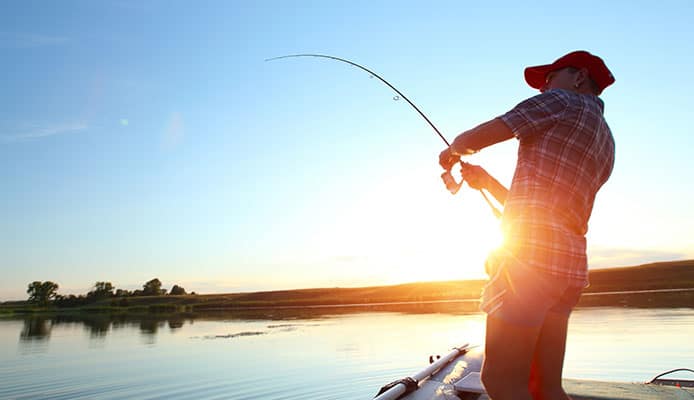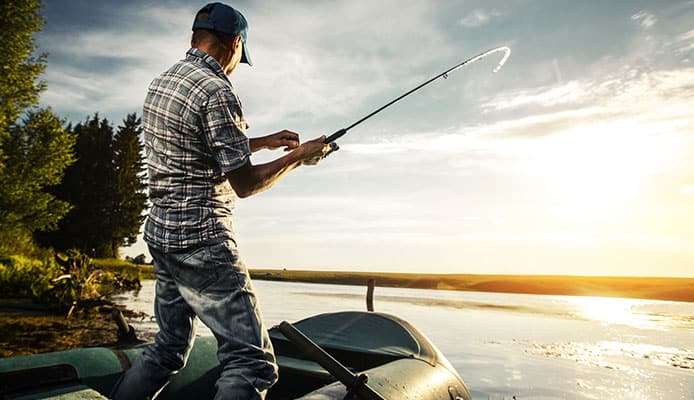
If you are new to fishing, you may think that the gray seatrout, commonly referred to as the weakfish, is actually weak. The fish does not live up to what its name implies. It is actually capable of putting up a spirited fight once it gets hooked. The nickname is because the fish features a weak mouth which can tear through easily if you get too aggressive with your saltwater fishing rod.
Targeting the elusive gray seatrout can be both rewarding and addictive. The delicate-mouthed fish can be tough to land even after succeeding at driving a hook through its mouth. In this article, however, we will make weak fishing easier for new and experienced anglers. By the time you reach the end of this article, you should know how to catch weakfish.
When and Where to Go Weak Fishing
If you intend to go after the weakfish in the Northeast US bays, the ideal time to test whether your fish finder works is in April. This is the time the weakfish starts filtering in Northeast bays.
The weakfish is also common in the mid-Atlantic. You can find its total range between northern Florida and Nova Scotia. The fish usually spawns along the beaches, in larger estuaries, and mouths of inlets. During the late fall through the winter, the adult weakfish usually migrate offshore to the warmer waters in the south.
Specific Spots Where You Can Find the Weakfish
Most fishermen have a routine where they head to the same fishing spots. This can easily lead to a rut. When looking for weakfish, you must keep expanding your search if you cannot find the fish in your usual favorite spots.
The tide is an essential factor when you are trying to locate the weakfish (we will explain this later in the article). For this reason, you may want to go weak fishing near the inlet, where the tide tends to run strongest. If you study the tide tables, you should have the ability to expand your weakfish search and reach large contour changes and deeper holes which can be easily identified by your handheld fishing GPS unit.
Taking advantage of the electronics, such as the best fish finders, can make weak fishing much easier for you. If your fishing electronics are not marking any fish, there is a chance that the fish you are currently after is not available in your current spot.
Instead of just relying on the spots where the weakfish relax while waiting for their prey, finding as many spots for weak fishing as possible is a good idea. Due to the tides, the wind, the weather, and other factors, you may not have the ability to fish in the same spot every day. For example, if the wind is currently blowing hard from the north, fishing on the south side may become impossible.
The Ideal Lures for Weak Fishing
To know how to catch weakfish, you have to understand the lures which appeal to the fish. The weakfish is generally an assertive predator. It feeds primarily upon smaller forage fish and invertebrates. Their prey includes scup, spot, small crabs, squid, shrimps, killifish, worms, and herring.
Although the weakfish is capable of attaining a weight of approximately 20 pounds, it is more likely for both experts and fishing beginners to catch a weakfish weighing about 10 pounds. While a 10-pound weakfish is big, swallowing an adult bunker will be tough for the fish.
Gathering smaller live lures, such as shrimps and killifish, can be time-consuming. Since it is possible to reel in a catch when going after the weakfish using artificial lures, most anglers prefer the artificial lures over the live ones.
Some of the best artificial lures you can attach to your best fishing line when weak fishing include small bucktails, soft-plastic swim shads, epoxy jigs, Z-man swim baits, Berkley Gulp, and diamond jigs. The best artificial plastic you can use with your baitcasting rod is the jelly worm. Jelly worms feature a slow waving tail and slender body. These 2 features make them irresistible to the weakfish.
When choosing your weak fishing lure. There are a couple of factors you may need to consider. The factors include:
- Current speed
- Water depth
- Weather conditions
If you are weak fishing in fast-moving waters, use a lure that has the ability to get to the holes where the weakfish usually hangs out. To give you an example, if you are fishing in slow-moving waters, catching the weakfish using 3-inch swimbaits on lightweight jigheads should be possible. Logically, more current will require a heavier presentation.
If you would like to use something that appears more natural, you can always tip your jig with a squid strip. Also, you can make use of sandworms on your high-low rig. The high-low rig makes it possible for you to present 2 natural baits at once, one above and one close to the bottom. Since the weakfish loves the shrimp, you can purchase a 3-inch shrimp from your local fish market and use it to add scent to the presentation.
You might also like: The Best Surf Casting Techniques
Factors to Consider When Deciding the Ideal Time for Weak Fishing

1. The Current
If you talk to anglers who are familiar with how to catch weakfish, you may hear them call the spring weakfish tide runners. This is for a reason. The weakfish feeds on both sides of the tides. Therefore, whenever you wear your best fishing shirt and decide to go weak fishing, you will need to find moving water.
The trophy weakfish is generally a lazy feeder. They usually stay in the holes, waiting for meals. When the water movement shifts/changes direction, they face into the current hoping an easy meal passes by.
2. The Wind Direction
Apart from taking note of the tides and current, you have to consider the wind. You will need to find the fishing conditions which have the wind working perfectly in conjunction with the current or tide.
Wind against the tide is generally a disaster for weakfish. If the wind is working against the tide, 2 major factors make it difficult for you to present your bait. First, your fishing boat will appear to be anchored while the wind blows in one direction and the tide pushes in the opposite direction. Second, your presentation will be drifting in the opposite direction the gray seatrout is facing.
3. Boat Traffic
When looking for weakfish, you will need to visit spots that do not feature a lot of boat traffic after wearing your best fishing hat. The weakfish is pretty skittish. When the boat traffic builds, the bite usually turns off. This makes catching the weakfish tough.
4. Time of the Day
If you do like getting up early, the best time of the day to go fishing for the weakfish is the false dawn. False dawn, in this case, refers to the transient light period which precedes the sunrise by approximately 60 minutes.
What makes this time ideal for weak fishing is the minimal winds and light traffic. This offers anglers the optimal conditions to target the boat-shy weakfish while it is feeding actively.
Combining the above factors should give you a better idea of when to pack the various types of fishing lines you own and go after the weakfish. The ideal time should be a false dawn when the tide is with the wind.
Selecting the Rod and Reel Setting
Making sure that you have the best fishing rod and reel can make all the difference. With the wrong rod, even someone who learned how to catch weakfish recently can catch more weakfish than you.
In some instances, neither the color of the lure, the type of bait you are using, nor your pound-test line will matter. If you are hooking weakfish but having trouble landing them, chances are, your rod is too heavy. When using a heavy rod, you will keep pulling your fishing hook from their incredibly thin lips.
The ideal rod for weak fishing should be 6-foot-6-inch. It should have medium or light power and fast action. This type of fishing rod is flexible enough to allow the weakfish some give during your final hookup.
The reel’s drag setting is also extremely important when you are weak fishing. Because of the weakfish’s weak mouth, you should keep the drag loose. If the reel offers heavy resistance, the reel might end up causing the hook to pull.
Globo Surf Overview
Weak fishing can be tough in the beginning. However, when you understand how to hook and land the fish, weak fishing can turn into an addictive hobby. This article shows you how to catch weakfish. When applied properly, the tips in this article are capable of making weak fishing incredibly simple.
If you intend to go after weakfish in the US, it is important to note that the catch and size limits may vary from state to state. Whenever you decide to go weak fishing, it is essential to ensure that you comply with the state regulations.

